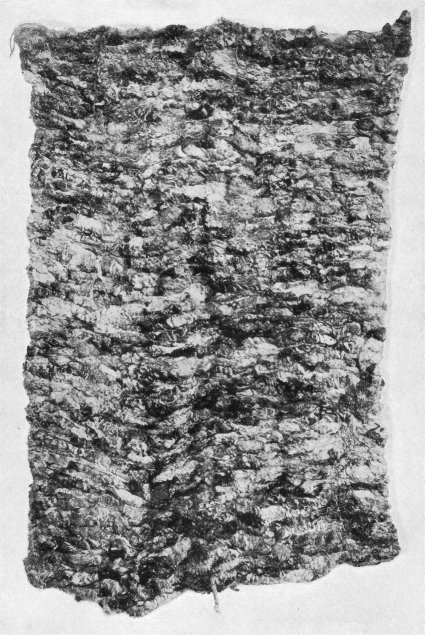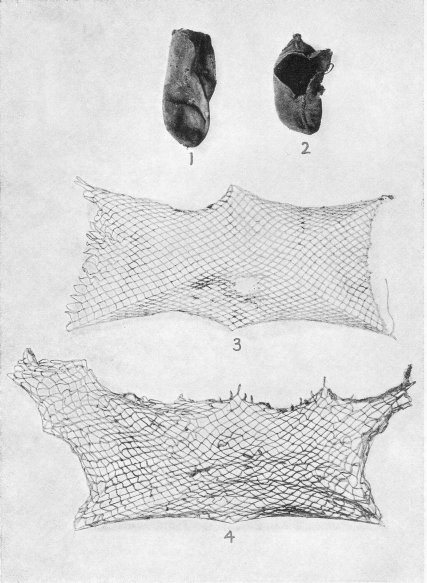
[click to enlarge]
| Online Library: | Title | Author | California | Geology | History | Indians | Muir | Mountaineering | Nature | Management |
Yosemite > Library > Miwok Material Culture > Clothing >
Next: Hair • Contents • Previous: Looped Stirrers & Paddles
Children wore no clothing until about ten years of age. The man’s clothing, when any was worn, consisted ordinarily of a simple breech clout (taplawū', N) of buckskin which passed between the legs and hung from a buckskin girdle (patca, lūta, C) as a short apron at the front and back.
The woman’s dress83 consisted, in the north, of a buckskin skirt (hū'te, N), which was a simple sarong-like wrapping about the loins. It reached to about half way between the knees and the ankles and had a fringe several inches in length. In addition to this dress and an oblique band of buckskin across each shoulder, the Central Miwok used more commonly a two-piece dress. The rear one (se'kī, C) was donned first. The front dress or apron (he'ssa, C) was then put on to overlap the two edges of the back dress. The Central Miwok also wore two-piece grass skirts reaching from the waist to the knees, and in suitable localities skirts (poso'wan, P) were made of shredded tule. Under the skirt the women wore a buckskin clout almost identical to that worn by the men, but called he'tta (N). Cedar bark was not used for skirts. No basket caps were worn.
When the weather required both sexes wore blankets. These were made from dressed skins of various animals: deer, bear, mountain lion, coyote, and others. Buffalo skins were sometimes used. These were obtained by trade from the Washo and Eastern Mono.84 Mo'a (C) was a blanket of two or more sewed deerskins. The commonest blanket, however, was made by winding narrow strips of rabbit skin about cords and weaving these, using plain cord as woof, into a loose but very warm blanket (plate LXI). It was called ūdjū'le (P), yū'ptī (N, C, S). All blankets, particularly of rabbit skin, were used especially as bed covers, but served as garments in cold weather. Except for rabbit skin blankets made in the low foothill region, the Miwok imported most of theirs from the Washo in the north and the Eastern Mono in the south.
A rare type of blanket (le'ka, P; to'nnī, N) was made of duck or goose feathers. The individual feathers were bound to a central cord by a smaller wrapping cord, thus producing a feather rope. Such strands formed the warp for a blanket similar to the rabbit skin robe. It was used almost entirely as an outer garment, but not subjected to rough usage. It was rarely seen in the mountains.
No feather skirt was worn by the Miwok, except the ceremonial one elsewhere described.
A much prized feather belt, ya'yame (N), was worn as a decoration and used as a medium of exchange. The Central Miwok made belts of California woodpecker (palatada, C) scalps, sewed on a buckskin belt and fringed with olive shell disks (tunni, C). Such belts were worn by rich men, their wives, and daughters. Also, belts (tē'pa, P, N; lü'taiya, N; lu'ta, C) were made of shell beads.
Ordinarily no foot covering was worn, but moccasins (solo'me, P, N; mamko, C) were used in cold weather and for journeys in very rough country. The moccasin was a one-piece affair of buckskin, lined with shredded cedar bark. There was a seam up the heel and up the front of the moccasin, sewed with milkweed fiber thread. Overlapping pieces were bound around the ankle. The moccasins were made by men, though worn by both sexes. The examples in plate LXII, figs. 1 and 2, are of Washo origin, but illustrate the Miwok type. They give evidence of having had an outer heel and sole sewed to the bottom. The top flaps have been cut away.
———
83Powers (p. 348)
states that “both sexes and all ages went absolutely
naked.”
84For discussion of western occurrences of buffalo, see Merriam, 1926.

[click to enlarge] |
Jackrabbit-skin blanket. Width about 1700 mm. Obtained from Northern Miwok, but purchased by them from the Washo. Spec. No. 1-9919. Neg. No. 8278.

[click to enlarge] |
Figure 1. Summer moccasin, showing mended sole. Spec. No. 1-10129b (C). Length about 225 mm.
Figure 2. Summer moccasin. Spec. No. 1-10129a (C).
Figure 3. Cotton hair net. Spec. No. 1-9981 (N).
Figure 4. Cotton hair net. Spec. No. 1-10041 (N).
Neg. No. 8280.
Next: Hair • Contents • Previous: Looped Stirrers & Paddles
| Online Library: | Title | Author | California | Geology | History | Indians | Muir | Mountaineering | Nature | Management |
http://www.yosemite.ca.us/library/miwok_material_culture/clothing.html